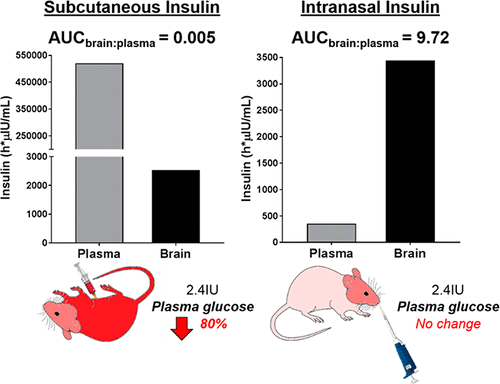当前位置:
X-MOL 学术
›
ACS Chem. Neurosci.
›
论文详情
Our official English website, www.x-mol.net, welcomes your feedback! (Note: you will need to create a separate account there.)
Pharmacokinetics of Intranasal versus Subcutaneous Insulin in the Mouse
ACS Chemical Neuroscience ( IF 5 ) Pub Date : 2017-12-19 00:00:00 , DOI: 10.1021/acschemneuro.7b00434 Michael T Nedelcovych , Alexandra J Gadiano , Ying Wu , Arena A Manning , Ajit G Thomas , Saja S Khuder , Seung-Wan Yoo , Jiadi Xu , Justin C McArthur , Norman J Haughey , David J Volsky 1 , Rana Rais , Barbara S Slusher
ACS Chemical Neuroscience ( IF 5 ) Pub Date : 2017-12-19 00:00:00 , DOI: 10.1021/acschemneuro.7b00434 Michael T Nedelcovych , Alexandra J Gadiano , Ying Wu , Arena A Manning , Ajit G Thomas , Saja S Khuder , Seung-Wan Yoo , Jiadi Xu , Justin C McArthur , Norman J Haughey , David J Volsky 1 , Rana Rais , Barbara S Slusher
Affiliation

|
Insulin delivery to the brain has emerged as an important therapeutic target for cognitive disorders associated with abnormal brain energy metabolism. Although insulin is transported across the blood–brain barrier, peripheral routes of administration are problematic due to systemic effects of insulin on blood glucose. Intranasal (IN) administration is being investigated as an alternative route. We conducted a head-to-head comparison of subcutaneous (SC) and IN insulin, assessing plasma and brain pharmacokinetics and blood glucose levels in the mouse. SC insulin (2.4 IU) achieved therapeutically relevant concentrations in the brain (AUCbrain = 2537 h·μIU/mL) but dramatically increased plasma insulin (AUCplasma = 520 351 h·*μIU/mL), resulting in severe hypoglycemia and in some cases death. IN administration of the same dose resulted in similar insulin levels in the brain (AUCbrain = 3442 h·μIU/mL) but substantially lower plasma concentrations (AUCplasma = 354 h·μIU/mL), amounting to a ∼ 2000-fold increase in the AUCbrain:plasma ratio relative to SC. IN dosing also had no significant effect on blood glucose. When administered daily for 9 days, IN insulin increased brain glucose and energy metabolite concentrations (e.g., adenosine triphosphate and phosphocreatine) without causing overt toxicity, suggesting that IN insulin may be a safe therapeutic option for cognitively impaired patients.
中文翻译:

小鼠鼻内与皮下胰岛素的药代动力学
向大脑输送胰岛素已成为与异常脑能量代谢相关的认知障碍的重要治疗靶点。尽管胰岛素通过血脑屏障转运,但由于胰岛素对血糖的全身作用,外周给药途径存在问题。正在研究鼻内 (IN) 给药作为替代途径。我们对皮下 (SC) 和 IN 胰岛素进行了头对头比较,评估了小鼠的血浆和脑药代动力学和血糖水平。SC 胰岛素 (2.4 IU) 在脑中达到治疗相关浓度 (AUC脑= 2537 h·μIU/mL) 但显着增加血浆胰岛素 (AUC血浆= 520 351 h·*μIU/mL),导致严重的低血糖,在某些情况下导致死亡。相同剂量的 IN 给药导致脑中的胰岛素水平相似(AUC脑= 3442 h·μIU/mL),但血浆浓度显着降低(AUC血浆= 354 h·μIU/mL),增加约 2000 倍在 AUC 中脑:血浆相对于 SC 的比率。IN给药对血糖也没有显着影响。每天服用 9 天时,IN 胰岛素增加脑葡萄糖和能量代谢物浓度(例如,三磷酸腺苷和磷酸肌酸)而不会引起明显的毒性,这表明 IN 胰岛素可能是认知障碍患者的安全治疗选择。
更新日期:2017-12-19
中文翻译:

小鼠鼻内与皮下胰岛素的药代动力学
向大脑输送胰岛素已成为与异常脑能量代谢相关的认知障碍的重要治疗靶点。尽管胰岛素通过血脑屏障转运,但由于胰岛素对血糖的全身作用,外周给药途径存在问题。正在研究鼻内 (IN) 给药作为替代途径。我们对皮下 (SC) 和 IN 胰岛素进行了头对头比较,评估了小鼠的血浆和脑药代动力学和血糖水平。SC 胰岛素 (2.4 IU) 在脑中达到治疗相关浓度 (AUC脑= 2537 h·μIU/mL) 但显着增加血浆胰岛素 (AUC血浆= 520 351 h·*μIU/mL),导致严重的低血糖,在某些情况下导致死亡。相同剂量的 IN 给药导致脑中的胰岛素水平相似(AUC脑= 3442 h·μIU/mL),但血浆浓度显着降低(AUC血浆= 354 h·μIU/mL),增加约 2000 倍在 AUC 中脑:血浆相对于 SC 的比率。IN给药对血糖也没有显着影响。每天服用 9 天时,IN 胰岛素增加脑葡萄糖和能量代谢物浓度(例如,三磷酸腺苷和磷酸肌酸)而不会引起明显的毒性,这表明 IN 胰岛素可能是认知障碍患者的安全治疗选择。


























 京公网安备 11010802027423号
京公网安备 11010802027423号